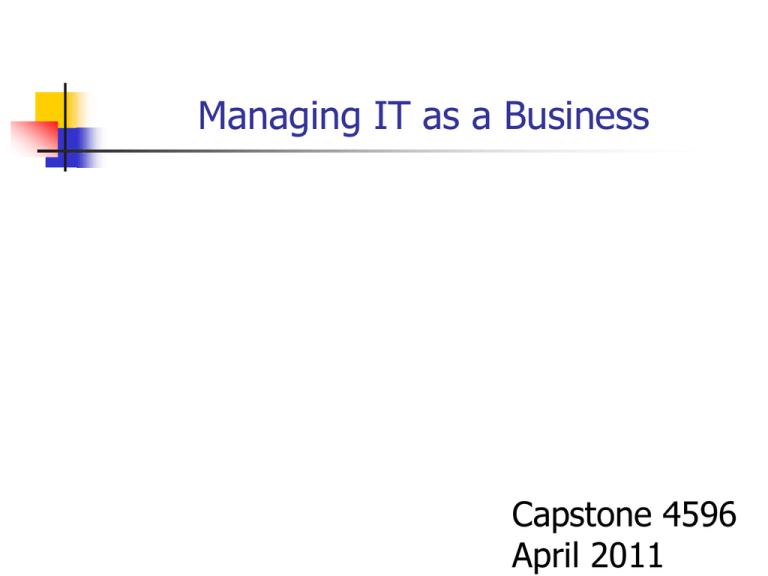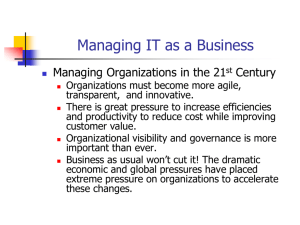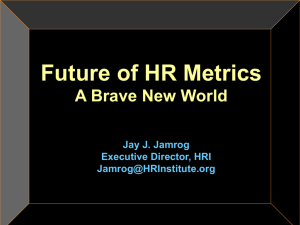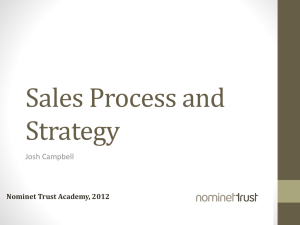The Importance of Information Technology in
advertisement

Managing IT as a Business Capstone 4596 April 2011 Managing IT as a Business Managing Organizations in the 21st Century Organizations must become more agile, transparent, and innovative. There is great pressure to increase efficiencies and productivity to reduce cost while improving customer value. Organizational visibility and governance is more important than ever. Business as usual won’t cut it! The dramatic economic and global pressures have placed extreme pressure on organizations to accelerate these changes. Managing IT as a Business Managing Organizations in the 21st Century Common Organizational Challenges Do More with Less – Productivity, Cost Reduction Need for Innovation Revenue and Expense Pressures Transparency Be Smarter Increase Service Value Collaboration – Internally & Externally Variable Cost Structure Managing IT as Business Managing Organizations in the 21st Century Common Organizational Requirements Visibility into the Organization Control – Metrics & Process to Manage Optimization – Continuous Improvement Transformational Change Leverage the Power of IT to Enable the Change Managing IT as a Business The Importance of IT / Business Alignment Business execs have high expectations of technology — but lower confidence that IT can deliver to these expectations. This is the new business technology alignment gap — a gap between expectations for technology and confidence in the IT organization. Members of the Forrester Leadership Boards CIO Group discussed this gap during recent meetings and shared their practices for closing it. Their strategy: Make sure IT is integrated with business planning — and make sure barriers between business and IT are minimized. Forrester, Dec 2008 Managing IT as a Business The Importance of IT / Business Alignment A recent article in Harvard Business Review (“Radically Simple IT,” March 2008 Issue) advocates that Business and IT shouldn’t just be aligned, they should be “forged together.” It is important that IT and Business work together in a team based collaborative process and develop a common set of metrics to measure performance. Managing IT as a Business Key Questions that Strategic Plans Should Address - Gartner Does the IT Strategy Substantiate Mutually Owned Expectations Developed by All Stakeholders? Are Critical Drivers Influencing the Direction of the IT Strategy Accounted For? Is the IT Investment Direction and Alignment With Business/Mission Needs and Priorities Made Explicitly Clear? Does the IT Plan Contain Performance Measures That Can Gauge Progress and Success Does the Plan Outline the Governance Process to Execute the Strategic Planning Process and Approved IT Investment Decision? Managing IT as a Business The Importance of IT / Business Alignment Why is it so difficult? Most IT plans do not indicate the business value and what strategic or tactical organizational benefit that the organization is trying to achieve. The CIO must report the IT value and guide other executives on achieving and reporting the contribution of the investment on the other executives goals. The CIO must have the ability to relate IT investments into business value. Art Jahnke Managing IT as a Business The Importance of IT / Business Alignment Software Project Disasters The 1995 Chaos Report was a landmark survey made by the Standish Group. This report is the study of IT project failure and is widely cited when IT project failures are being discussed The respondents to the Standish Group survey were IT executive managers. The total sample size was 365 respondents representing 8,380 applications. Managing IT as Business The Importance of IT / Business Alignment Findings - The Standish Group research showed a staggering 31.1% of projects would be cancelled before they ever get completed. Further results indicated that 52.7% of projects will cost over 189% of their original estimates. Based on this research, The Standish Group estimated that in 1995 American companies and government agencies would spend $81 billion for cancelled software projects and paid an additional $59 billion for software projects that would be completed, but exceeded their original time estimates and projects completed by the largest American companies had only approximately 42% of the originally-proposed features and functions. Managing IT as a Business 2009 Chaos Report -“This year's results … highest failure rate in over a decade” Projects 33% 44% 24% Succeeded Challenged Failed CHAOS Summary 2009 - Standish Group Managing IT as a Business A Review of the IT Environment The Challenge : How to Leverage New Technology to be more Innovative? Financial Pressures to cut spending Legacy Computer Systems 78% of IT Dollars spent to “Run the Trains” Human Capital Challenges Non Alignment between IT & Stakeholder Requirements Managing IT as a Business Current State Unpredictable Transformation Process Three-Phase Implementation Future State Reliable Missed Transforming Delivery IT to Achieve Dramatic Business Improvement On Time Dates Over Budget OPTIMIZATION Ineffective Productivity Measurements Rationed Staff High Cost CONTROL Within Budget High Productivity Variable Capacity VISIBILITY Lower Fixed Cost Managing IT as a Business A Review of the IT Environment Legacy Systems Run on Mainframe Technologies Senior Programmers Close to Retirement Work not Generally Documented Operating Systems Expensive Not Agile or Client Centric Difficult to Integrate with Newer Technology Managing IT as a Business A Review of the IT Environment Legacy Systems Recent research reports indicate that integration is increasingly becoming the focus for many businesses. Organizations face the challenge of integrating various and distinct business applications together with their existing legacy systems, in order to create an effective business and enhance productivity. Top IT experts conclude that 78 percent of an IT budget is spent just managing existing system and software infrastructures Managing IT as a Business A Review of the IT Environment Legacy Systems This is bad news for any organization looking to reduce IT costs. The fact that 78 percent of your IT budget is spent maintaining existing systems means less money for IT innovation and for alignment with business processes. It means that psychologically, IT managers have more of a stake in keeping current systems running, rather than looking for better ways to manage technology. Managing IT as a Business “Do it right” Assets of the Company Efficiency “Do the right thing” Strategic Vision Effectiveness IT Consulting Services Construction Management Services “Plan” “Build” Corporate Direction and Strategy Application Services Tracer Desktop Services “Run” IT Strategy Core K K K K Migrate the IT investment $ and/or resources to the high pay-off areas to the business. Business Enable Change Information Technology K = Knowledge Workers Increase levels of productivity – Run/Build Managing IT as a Business Standard Processes Managing with Metrics Automation Managing IT as a Business Defined Standard/Repeatable Processes Process/Performance/Product Metrics Quality Focus Standard Cost Model End to End Process Management Rock Solid Metrics Based Management Continuous Improvement Productivity Quality Managing IT as a Business Dramatically Lower Unit Costs Continuous Cost Reductions Higher Quality Improved Visibility Increased Controls Asset Optimization Increased IT Business Value Improved Capability Level Managing IT as a Business OPTIMIZATION Streamline & Craft Work Processes CONTROL VISIBILITY Implement Workflow Processes Classify and Capture Work, Metrics, Resources and Time 4-7 months Cumulative Timeline Managing IT as a Business Software Process – a set of activities, methods, practices and transformations that people employ to Develop and Maintain Software and associated products. - Mark Paulk, et al., The Capability Maturity Model, SEI Managing IT as a Business Standard Process Enables … Realization of Methodology Benefits Repeatable (Consistent, Reliable, Predictable) Execution Common Language to Communicate Activity, Status, Issues Managing IT as a Business Standard Process Enables … Realization of Methodology Benefits Quality Plans and Improvement Strategies Discrete Units of Work for Performance Specification and Impact Assessment Defined Quality Control Activities Implement Quality Assurance Strategy Meaningful Process Metrics Managing IT as a Business Standard Process Enables … Realization of Methodology Benefits Quality Plans and Improvement Strategies Tool Usage Benefit Maximization Deployment of Tool Across Organization Feedback/Tuning Experience Managing IT as a Business Managing With Metrics Managing IT as a Business Why Metrics are Important Business Goals - Define and Track Progress View Support Costs by Application/Program Enables Capacity Planning Conduct Periodic Customer Reviews Based on Facts Managing IT as a Business There is general agreement among practitioners that Standard Process and Managing with Metrics need to occur, but they haven’t. Why? Hard Hard Hard Hard to to to to Get Started Achieve Consistency Avoid Entropy Institutionalize We need help to ease the effort – The Answer - Automation Managing IT as a Business Software maintenance productivity can improve at rates of 10% to 40% PER YEAR - Capers Jones, Calculating the Value of PI Managing IT as a Business “Do it right” Assets of the Company Efficiency “Do the right thing” Strategic Vision Effectiveness IT Consulting Services Construction Management Services “Plan” “Build” Corporate Direction and Strategy Application Services Tracer Desktop Services “Run” IT Strategy Core K K K K Migrate the IT investment $ and/or resources to the high pay-off areas to the business. Business Enable Change Information Technology K = Knowledge Workers Increase levels of productivity – Run/Build










